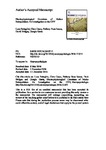Electrophysiological correlates of motion extrapolation: An investigation on the CNV
| dc.contributor.author | Battaglini, L | |
| dc.contributor.author | Casco, C | |
| dc.contributor.author | Isaacs, BR | |
| dc.contributor.author | Bridges, D | |
| dc.contributor.author | Ganis, Giorgio | |
| dc.date.accessioned | 2017-02-10T11:43:04Z | |
| dc.date.available | 2017-02-10T11:43:04Z | |
| dc.date.issued | 2017-01-27 | |
| dc.identifier.issn | 0028-3932 | |
| dc.identifier.issn | 1873-3514 | |
| dc.identifier.other | C | |
| dc.identifier.uri | http://hdl.handle.net/10026.1/8446 | |
| dc.description | publisher: Elsevier articletitle: Electrophysiological correlates of motion extrapolation: An investigation on the CNV journaltitle: Neuropsychologia articlelink: http://dx.doi.org/10.1016/j.neuropsychologia.2016.12.019 content_type: article copyright: © 2016 Elsevier Ltd. All rights reserved. | |
| dc.description.abstract |
Motion extrapolation (ME), the ability to estimate the current position of moving objects hidden by an occluder, is critical to interact with a dynamic environment. In a typical paradigm, participants estimate time to contact (TTC) by pressing a button when they estimate the occluded moving target reaches a certain cue. Research using this paradigm has shown that motion adaptation of the occluded area produces a shift in the TTC estimate (Gilden et al., 1995). We examined the effect of motion adaptation on the contingent negative variation (CNV), a frontal electrophysiological component (Tecce, 1972) that could reflect the activity of an accumulator (Buhusi and Meck, 2005) for time processing. We predicted that longer TTC estimates due to previous visual motion adaptation would result in a larger CNV because the accumulator can collect more time units. Results showed that motion adaptation actually modulates the CNV, but the CNV amplitude did not correlate with TTC duration, falsifying the accumulator hypothesis. We suggest that motion adaptation interferes with the remembered speed (stored during the visible part of the trajectory) that may be used as input by higher cognitive function to guide the temporal update of target position, regardless of the TTC estimate. | |
| dc.format.extent | 86-93 | |
| dc.format.medium | Print-Electronic | |
| dc.language | en | |
| dc.language.iso | en | |
| dc.publisher | Elsevier BV | |
| dc.subject | Motion extrapolation | |
| dc.subject | CNV | |
| dc.subject | Time to contact | |
| dc.title | Electrophysiological correlates of motion extrapolation: An investigation on the CNV | |
| dc.type | journal-article | |
| dc.type | Journal Article | |
| plymouth.author-url | https://www.webofscience.com/api/gateway?GWVersion=2&SrcApp=PARTNER_APP&SrcAuth=LinksAMR&KeyUT=WOS:000393723900008&DestLinkType=FullRecord&DestApp=ALL_WOS&UsrCustomerID=11bb513d99f797142bcfeffcc58ea008 | |
| plymouth.volume | 95 | |
| plymouth.publication-status | Published | |
| plymouth.journal | Neuropsychologia | |
| dc.identifier.doi | 10.1016/j.neuropsychologia.2016.12.019 | |
| plymouth.organisational-group | /Plymouth | |
| plymouth.organisational-group | /Plymouth/Faculty of Health | |
| plymouth.organisational-group | /Plymouth/Faculty of Health/School of Psychology | |
| plymouth.organisational-group | /Plymouth/REF 2021 Researchers by UoA | |
| plymouth.organisational-group | /Plymouth/REF 2021 Researchers by UoA/UoA04 Psychology, Psychiatry and Neuroscience | |
| plymouth.organisational-group | /Plymouth/REF 2021 Researchers by UoA/UoA04 Psychology, Psychiatry and Neuroscience/UoA04 REF peer reviewers | |
| plymouth.organisational-group | /Plymouth/Research Groups | |
| plymouth.organisational-group | /Plymouth/Research Groups/Centre for Brain, Cognition and Behaviour (CBCB) | |
| plymouth.organisational-group | /Plymouth/Research Groups/Centre for Brain, Cognition and Behaviour (CBCB)/Brain | |
| plymouth.organisational-group | /Plymouth/Users by role | |
| plymouth.organisational-group | /Plymouth/Users by role/Academics | |
| dc.publisher.place | England | |
| dcterms.dateAccepted | 2016-12-13 | |
| dc.rights.embargodate | 2017-12-13 | |
| dc.identifier.eissn | 1873-3514 | |
| dc.rights.embargoperiod | 12 months | |
| rioxxterms.versionofrecord | 10.1016/j.neuropsychologia.2016.12.019 | |
| rioxxterms.licenseref.uri | http://www.rioxx.net/licenses/under-embargo-all-rights-reserved | |
| rioxxterms.licenseref.startdate | 2017-01-27 | |
| rioxxterms.type | Journal Article/Review |


